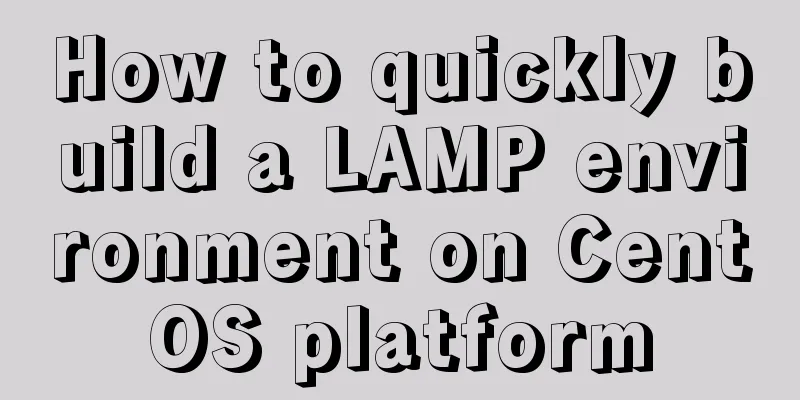How to quickly build a LAMP environment on CentOS platform

|
This article uses an example to describe how to quickly build a LAMP environment on the CentOS platform. Share with you for your reference, the details are as follows: LAMP -- Linux Apache MySQL PHP The order of installation on CentOS is usually Apache -> MySQL -> PHP Step 1: Install and configure Apache 1. Install using yum yum install httpd 2. Modify the firewall configuration and open port 80. You can also open port 3306 of MySQL. vi /etc/sysconfig/iptables Add two records -A INPUT -m state --state NEW -m tcp -p tcp --dport 80 -j ACCEPT -A INPUT -m state --state NEW -m tcp -p tcp --dport 3306 -j ACCEPT Note the location of the addition, as shown below
3. Turn off SELINUX vi /etc/selinux/config Modify SELINUX=disabled 4. Apache configuration file vi /etc/httpd/conf/httpd.conf Find ServerName and set it to your own domain name. If you don’t have a domain name, you can set it to localhost:80 5. Automatically start Apache at boot chkconfig httpd on 6. Restart Apache service httpd restart 7. Open the browser and enter the address test Step 2: Install and configure MySQL 1. Install using yum yum install mysql mysql-server 2. Automatically start MySQL at boot chkconfig mysqld on 3. Set the root password for MySQL mysql_secure_installation After pressing Enter, enter y to set the password. After setting the password, press Enter all the way until the following message appears: Thanks for using MySQL! 4. Restart MySQL service mysqld restart Step 3: Install and configure PHP 1. Install using yum yum install php 2. Install PHP components yum install php-mysql php-gd libjpeg* php-imap php-ldap php-odbc php-pear php-xml php-xmlrpc php-mbstring php-mcrypt php-bcmath php-mhash libmcrypt 3. Restart Apache and MySQL 4. You can upload PHP files for testing in the default code directory, the default directory is /var/www/html . The path can be modified in the httpd.conf file. *Then, you can configure Apache MySQL PHP according to your specific needs. The default configuration file path is as follows: Apache configuration file path: /etc/httpd/conf/httpd.conf I hope this article will help you maintain your CentOS server. You may also be interested in:
|
<<: More Features of the JavaScript Console
>>: How to make full use of multi-core CPU in node.js
Recommend
Detailed discussion of several methods for deduplicating JavaScript arrays
Table of contents 1. Set Deduplication 2. Double ...
In-depth analysis of the Linux kernel macro container_of
1. As mentioned above I saw this macro when I was...
Vue implements adding watermark effect to the page
Recently, when I was working on a project, I was ...
Solve the problem of IDEA configuring tomcat startup error
The following two errors were encountered when co...
Linux file system operation implementation
This reading note mainly records the operations r...
CSS sets the list style and creates the navigation menu implementation code
1. Set the list symbol list-style-type: attribute...
Detailed explanation of the implementation principle of transaction isolation level in MySQL
Preface When it comes to database transactions, a...
JavaScript implements H5 gold coin function (example code)
Today I made a Spring Festival gold coin red enve...
JD Vue3 component library supports the detailed process of mini program development
Source code preview: https://github.com/jdf2e/nut...
Docker Compose one-click ELK deployment method implementation
Install Filebeat has completely replaced Logstash...
How to implement rounded corners with CSS3 using JS
I found an example when I was looking for a way t...
How to remove spaces or specified characters in a string in Shell
There are many methods on the Internet that, alth...
Getting Started Guide to Converting Vue to React
Table of contents design Component Communication ...
MySQL slow query method and example
1. Introduction By enabling the slow query log, M...
7 skills that great graphic designers need to master
1》Be good at web design 2》Know how to design web p...










